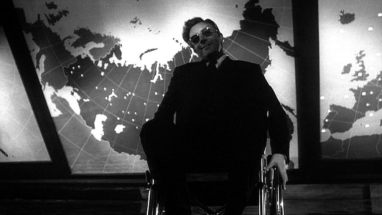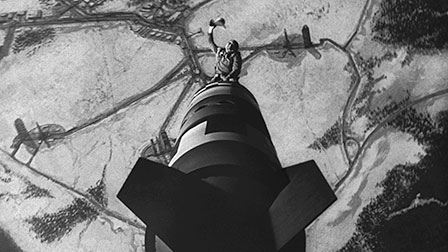Before taking this class I only knew Stanley Kubrick by one movie. That movie was Dr. Strangelove. I was able to watch this in a film theory class here at NIU. This movie itself gave me a sense of Kubrick himself. The shot composition, dark humor, and ability to have such dedicated characters.
I want to dedicate this blog to the sole movie, Dr. Strangelove. I want to look at certain aspects of the film. The shot composition, dark humor, and the odd character of Strangelove himself.
Kubrick’s shot composition in this movie goes along way to how he wants audiences to see his work. One particular shot that I thought was interesting was when they introduced Dr. Strangelove in the end. The shot starts off with Dr. Strangelove moving towards the camera from a dark cloud. It is hard to see him, and then he slowly becomes visible as he gets closer. I find this interesting because of his oddly, dark character already. Kubrick used a lot of dark humor in this movie, and I have a feeling that he might have carefully chose to have Dr. Strangelove come in really dark the way he did. The different angles of this scene were unique to really understand his character. The close-ups, to the wide shot, to the shots of everyone watching him embarrass himself with the Hitler references.
Another aspect that I found interesting about Kubrick’s directing is his use of dark humor. In Dr. Strangelove, there are many examples that help make the audience laugh. This dark humor is used to almost distract a serious issue going on at the time in this movie. In one scene that most of the class laughed at the most was when General “Bat” was more worried about the after math of shooting the Coca-Cola machine than calling off the nuclear attack. Goes to show that Kubrick never feared humor with a serious object. Another example of Kubrick’s dark humor was when Major Kong promised promotions to his crew once the mission was over. Turns out this mission doesn’t end well, in which the crew barely will be able to receive anything since the explosion.
Dr. Strangelove came off as a very odd character to me, so I decided to look into his background. Dr. Strangelove was based on four famous German scientists and political figures. His character had traces of rocket scientist Wernher Von Braun, military strategist Herman Kahn, Manhattan Project kingpin John Von Neumann, and hydrogen bomb designer Edward Teller. Peter Sellers who was Dr. Strangelove took on a role of four characters in this movie. Sellers was demanded to play these characters, and in my eyes he played these characters well. Dr. Strangelove was a strange man, but he had a background full of scientists that created him.
Overall, Dr. Strangelove was a movie that I would definitely tell others to watch. The shot composition, dark humor, and dedication of certain characters helped make this film one of my favorites from Kubrick.


Hi Ryan, testing out blog comments on sites. Carry on! -RP
LikeLike
I like your analysis of the lighting and it’s, accidental or purposeful, comparison to the humor that is shown in the movie; you seem to allude to the darker, higher key lighting reflecting the sardonic and dark humor that the characters show (Dr. Strangelove and his Nazi references, and General “Bat” and his issues with the soda machine). Dr. Strangelove is definitely one of my favorite movies by Kubrick, as well.
LikeLike
Even though I didn’t care for Dr. Strangelove, I agree that it’s a film that embodies all things Kubrick. I love that he isn’t afraid to use dark humor and take risks. Thanks for including that bit of information about Dr. Strangelove’s background, because I was definitely a little lost with his character.
LikeLike
The composition in the movie is really interesting as Kubrick adds a lot the story with it. One shot I really liked is when Major Kong goes down with the bomb and in the shot frame we can see that the bomb will land right in the middle of a heart made out of roads on the ground.
LikeLike
I like that you chose to focus on Dr. Strangelove for this blog. Especially since you are bringing up composition. Because, in my opinion, Dr. Strangelove is Kubrick’s strongest work in terms of composition and lighting. But, I also think that comes down to it being a black and white film, so it is much easier to notice. Interesting blog, Ryan.
LikeLike
Very interesting topic to talk about in this post, especially in the sense of talking about camera angles and Kubrick. One of my personal favorite angles would be from ‘Full Metal Jacket’ when the Drill Sarge would almost look like he’s yelling directly at you. Just center your picture of Dr.Strangelove and you’re post is golden!
LikeLike
You are on with your analysis. The humor comes from a dark place. I never thought about how the character of Dr. Strangelove came about. Our country relied on German scientists after WWII. Strangelove struggling with his inner Nazi was dark, but more than likely came from someone noticing the influence of these scientists.
LikeLike
I also enjoy Kubrick’s dark humor. As some stated in class. He knows how to use just enough and not make it cheesy. Like some movies today, they just go so over the top that it loses its appeal very quickly. With Kubrick, he leaves you wanting more and it never seems to get old.
LikeLike
I really liked the way you related Dr. Strangelove coming out of the dark shadow to his dark character. That’s a really interesting comparison, I didn’t see it that way at first! Also, I think it’s pretty cool how he played multiple different characters, and he played them great! I’m sure that must’ve been very difficult.
LikeLike